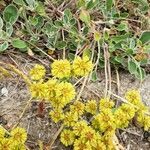Herbs, subshrubs, or shrubs, cespitose, matted or spreading, sometimes erect, often polygamo-dioecious, (0.2-)1-12(-20) × (0.5-)1-12(-20) dm, glabrous or tomentose. Stems: caudex spread-ing; aerial flowering stems spread-ing to erect or nearly so, slender, solid, not fistulose, arising at nodes of caudex branches and at distal nodes of short, nonflowering aerial branches, (0.1-)0.5-3(-4) dm, without a whorl of bracts at midlength. Leaves in loose to compact basal rosettes; petiole 0.1-3(-4) cm, mostly tomentose to floccose or glabrous; blade oblong-ovate or oblanceolate to elliptic to oval, 0.3-3(-4) × 0.1-2.5 cm, densely lanate to tomentose or floccose abaxially, tomentose to floccose or glabrous adaxially, occasionally glabrous on both surfaces, margins entire, plane or rarely wavy. Inflorescences umbellate or compound-umbellate, rarely subcapitate or capitate, 3-25 × 2-18 cm; branches tomentose to floccose or glabrous, rarely with whorl of bracts ca. midlength; bracts 3-several, semileaflike at proximal node, 0.3-2.5 × 0.2-1.8 cm, usually scalelike distally, 1-5 × 0.5-3 mm. Involucres 1 per node, turbinate to campanulate, 1-6 × (1-)1.5-10 mm, tomentose to thinly floccose or glabrous; teeth 6-12, lobelike, reflexed, 1-4(-6) mm. Flowers 2-10(-12) mm, including (0.7-)1.3-2 mm stipelike base; perianth various shades of white, yellow, or red, glabrous; tepals monomorphic, usually spatulate to obovate; stamens exserted, 2-8 mm; filaments pilose proximally. Achenes light brown to brown, 2-7 mm, glabrous except for sparsely pubescent beak.
More
A small plant that keeps growing from year to year. It grows 10 to 30 cm high. The leaves near the base are usually spoon shaped. They have white hairs underneath. The leaves on the stem are in a ring near the top of the stem. The stem divides into 6 or more smaller stalks near the top. The flowers are in umbrella like clusters at the top. The are pale green or yellow





